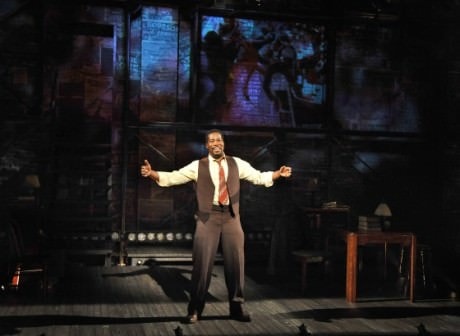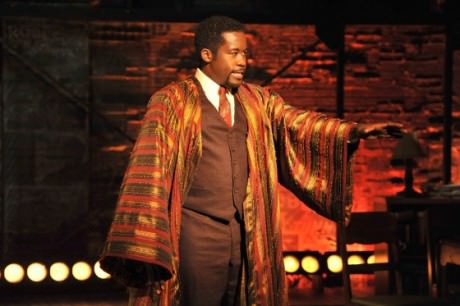The epic journey of the civil rights movement, the political struggles of the times, and the fruitless hatred of humankind towards those they do not understand are beautifully realized –and mirrored with texture and depth by Daniel Beaty as the famed Paul Robeson – in Moisés Kaufman’s brilliantly directed The Tallest Tree in the Forest. Now playing at the Arena Stage’s Kreeger Theater, this stimulating production is a refreshing paradox and contradiction on many levels. It is a one-man show played by Beaty, yet Beaty portrays close to forty distinct characters – effortlessly making the transitions with ease from portraying his father, his brother, his wife, Harry Truman, an investigator from the House on Un-American Activities (HUAC), press reporters, a scholar, and so forth and so on.

As well as the dramatic intensity and versatility on display here, we also have Beaty singing with a powerful baritone, fourteen songs that portray the mood of each stage of his life and times with just the right musical approach for each moment. If all this was not enough, Beaty wrote this play (which was produced in association with the Tectonic Theater Project), and the vast amount of material that the show encompasses in one hour and fifty minutes is mind-boggling.
Add to this abundance of riches , the enriching direction of Moisés Kaufman who has his own expertise in similar hows such as I Am My Own Wife and The Laramie Project, and you have a veritable cornucopia of pleasures to devour from the intellectual to the musical and to the political arenas. Beaty’s play is densely written, alternately full of real life events from Robeson’s life, yet almost epic in scope. Director Kaufman mines the material to place the accent on Robeson’s continual conflict over his role as Artist versus the Activist. Kaufman draws on all the mixed-media components of this fine play, cohesively unifying the various elements of text, acting, music, video projections, and set design into one organic whole.
Beaty’s strong stage presence and sheer physical stamina – in what must be a grueling marathon to play night after night – help to propel the play along from each vignette to the next. Beaty plays the role masterfully in a performance that shows all of the character’s struggles to make sense of the political and racial injustices he perceives in the world around him. He, concurrently, effectively shows how he is misunderstood and not fully appreciated as an artist by the public. Startlingly effective video projections – courtesy of Projection Designer John Narun – flashed against the back wall of the stage show all the many myriad events that shaped Robeson’s life from his visits to the Soviet Union, the onset of World War II, his many musical concerts and speeches, and the numbing effect of bigotry and racial intolerance as embodied in mob attacks and lynching. Beaty plays off these vivid scenes, utilizing theatrical counterpoint by easing into his next character or song with aplomb and finesse. Beaty opens the show with a thundering rendition of his classic standard “Ol’ Man River” and reprises it to even fuller effect later in the show. A rousing rendition of the famous song “Happy Days are Here Again” shocks the audience from any notion of complacency for, as we watch American revelers enjoying the fruits of victory in World War Two, we are soon confronted with horror of Lynching.
Beaty’s portrayal of Robeson is extremely complex as he never takes the easy way out by defining any one part of the man as his totality. Yes, this is a proud and strong man of dignity who inspired thousands but, conversely, here is the tortured, vulnerable man who sings joyous songs and spirituals while trying to salvage his wounded pride and stand up for his beliefs in a world that finally turns on him and cuts him down to size. Robeson here is portrayed as a scapegoat for the mob mentality—he is accused of being a Communist (the scene where he appears before HUAC is a standout), his passport is revoked(another searing scene), his concerts are cancelled and his wife has died, yet he never gives up. This aspect is what makes Robeson (and his portrayal by Beaty) so fascinating; no matter the circumstance, this Paul Robeson stands tall. At various moments in the play and especially at the end, there is sadness and pain in Beaty’s portrayal , yet – as he ruminates on his life-he realizes that the civil rights he was fighting for were finally beginning to take place. Perhaps it was all worth it even though he was put through the trials of Hell in his own personal life.

The wonderfully evocative video projections previously mentioned blend seamlessly with a perfectly realized set by Set Designer Derek McLane. Textures of brown and grey abound on Arena’s Kreeger Stage and, though this play covers a wide-scale of events, we are drawn to the intimacy of a desk, a table and a bureau in Robeson’s home. This quaint domestic space is contrasted against large metallic stairs, scaffolding and panels that hang against the back wall. What appears to be a blank wall suddenly opens up to reveal an open door. Utilization of the space is full of surprises and delights.
Lighting Designer David Lander has done a superb job of lighting the proceedings. Lighting is appropriately gloomy when necessary or, alternately, uplifting and all-encompassing when the moment calls for it. The use of strobe lights is handled deftly.
At the far rear corners of the stage, the musicians who handle the subtle interplay of the music can be glimpsed but a glimpse is all that is needed for the musical accompaniment is, indeed, glorious. Music Director/Conductor and Pianist Kenny J. Seymour handles musical chores with evident relish. On the clarinet and flute, Rita Eggert plays beautifully as does Aron Rider on cello. Sound Designer Lindsay Jones provides resonant sound effects throughout.
The Tallest Tree in the Forest is destined for high praise on Broadway.
Running Time: One Hour and 50 minutes, with one fifteen-minute intermission.
The Tallest Tree in the Forest plays through February 16, 2014 at the Kreeger Theater at Arena Stage at The Mead Center for American Theater -1101 Sixth Street, SW, in Washington, DC. For tickets call (202) 488-3300, or purchase them online.





